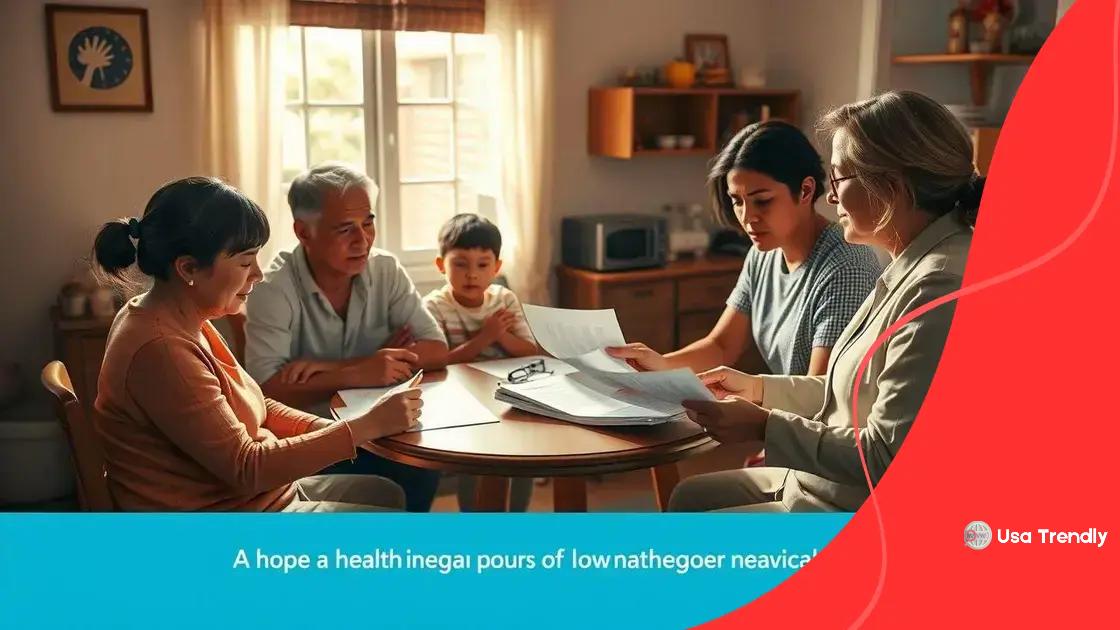Healthcare subsidy adjustments implemented: what you need to know

Healthcare subsidy adjustments implemented increase financial assistance, making healthcare more accessible for low-income families and helping them navigate the application process effectively.
Healthcare subsidy adjustments implemented have the potential to reshape the landscape of medical services for many individuals. Have you ever wondered how these changes might directly affect your access to care? Let’s dive into the details.
Understanding healthcare subsidies
Understanding healthcare subsidies is essential for grasping how they help individuals access necessary medical services. These subsidies allow many families to receive care that might otherwise be unaffordable.
What Are Healthcare Subsidies?
Healthcare subsidies are financial assistance programs designed to help individuals and families pay for health insurance. They aim to make healthcare more accessible by reducing monthly premiums and out-of-pocket costs. Many people qualify for subsidies based on their income and household size.
How Do Subsidies Work?
Subsidies adjust based on your income level, meaning lower-income families receive more extensive support. These adjustments can significantly impact the affordability of healthcare. It’s important to understand how this works, especially during open enrollment periods.
- Subsidies are available for those who purchase insurance through the health marketplace.
- Eligibility is determined by your income relative to the federal poverty level.
- Subsidies can cover a significant portion of premium costs.
- They also help with out-of-pocket expenses such as deductibles and copayments.
Many aspects of healthcare subsidies are often misunderstood. People frequently confuse subsidies with outright healthcare coverage. However, subsidies primarily assist in lowering costs rather than providing direct coverage. Understanding the distinction is crucial for making informed health insurance choices.
Moreover, there are different types of subsidies, including tax credits and cost-sharing reductions. Tax credits offer reductions in the amount of tax you owe, while cost-sharing reductions directly lower out-of-pocket costs. By navigating these options, individuals can find the best solution for their healthcare needs.
Why Are They Important?
Healthcare subsidies play a vital role in maintaining public health. They ensure that more people can access preventive services, leading to better health outcomes overall. By encouraging individuals to seek medical help when needed, subsidies help avoid more significant health issues down the line.
Overall, understanding healthcare subsidies is crucial for everyone, especially those looking for health insurance. They can open the door to necessary services and provide peace of mind for families across the country.
Recent adjustments in healthcare subsidies
Recent adjustments in healthcare subsidies have brought significant changes that affect many individuals and families across the country. These changes are essential to understand, as they impact access to affordable health insurance.
What Are the Recent Changes?
Recent adjustments include increased financial assistance for low-income families and modifications to eligibility requirements. This means more people can now qualify for aid, allowing better access to healthcare services. The changes aim to address ongoing issues within the healthcare system, providing relief where it is most needed.
How Do These Changes Affect You?
With these adjustments, individuals may find themselves eligible for these benefits even if they weren’t before. This financial help can lower monthly premiums and other costs associated with health insurance. Some people may see a decrease in their overall healthcare expenses, making it easier to seek necessary medical attention.
- Lower eligibility thresholds will allow more families to receive assistance.
- Increased premium tax credits make healthcare more affordable.
- Cost-sharing support remains available for eligible individuals.
- Plans may cover a broader range of services due to adjustments.
Additionally, these adjustments to healthcare subsidies reflect a growing acknowledgment of the need to improve access to healthcare across various demographics. By increasing support for those in need, the government aims to enhance public health outcomes and reduce disparities in healthcare access.
As people become aware of these recent changes, it is vital to assess how they may reshape personal healthcare plans. Families are encouraged to reevaluate their options during open enrollment periods to take full advantage of these adjustments. Knowing your options empowers you to make informed decisions regarding healthcare coverage.
What to Consider Moving Forward
When looking at the recent adjustments in healthcare subsidies, consider your current health needs and financial situation. If your income or family size has changed, you might be eligible for a different subsidy amount. Also, remember that understanding these subsidies can help you budget for your healthcare expenses better.
In conclusion, keeping informed about these adjustments allows individuals to advocate for their healthcare needs effectively. The recent changes serve as a reminder that healthcare affordability remains a necessary discussion across the nation.
Impact of subsidy changes on low-income families

The impact of subsidy changes on low-income families is profound and necessary to comprehend. These adjustments can dramatically alter how families access healthcare services.
Increased Accessibility
With new subsidy regulations, many low-income families can now afford health insurance that was previously out of reach. The increase in financial assistance means that more individuals can seek preventive care. This helps families maintain better health and avoid serious medical conditions.
Financial Relief
These changes provide critical financial relief for households struggling to cover medical costs. Lower premiums and increased coverage reduce the financial burden, allowing families to allocate resources to other essential needs such as food and housing.
- Families can save more on monthly insurance premiums.
- Out-of-pocket costs for doctor visits and medications may decrease.
- Better health coverage options are available, leading to comprehensive care.
- Fewer families face medical debt due to affordable care.
This enhanced support not only eases financial stress but also empowers low-income families to seek necessary medical attention without fear of overwhelming costs. It encourages regular check-ups and timely interventions, which are crucial for maintaining overall health.
As families adapt to these changes, they often find themselves more informed about their healthcare options. Understanding the implications of these subsidies can lead to better healthcare decisions. Low-income families are encouraged to explore their new options and select plans that best meet their needs.
The Bigger Picture
Overall, the impact of subsidy changes extends beyond individual families to benefit communities as a whole. A healthier population reduces strain on public health systems and promotes a more productive society. By ensuring that low-income families have access to necessary healthcare, these adjustments play a vital role in improving public health outcomes.
Future of healthcare subsidies in the U.S.
The future of healthcare subsidies in the U.S. looks promising as reforms continue to evolve. These changes aim to improve access to essential medical services for all citizens.
Expanding Coverage
One key focus for the future is expanding coverage for a broader segment of the population. Policymakers aim to increase the number of individuals eligible for subsidies. By doing this, they hope to reduce the number of uninsured Americans.
Potential Policy Changes
Upcoming policy changes may further enhance the affordability of health insurance. Many expect new legislation to increase subsidy amounts, making premiums lower for families in need. These adjustments could also include guidelines that simplify the enrollment process, encouraging more people to participate.
- More inclusive eligibility criteria will target vulnerable communities.
- Increased funding for subsidy programs can enhance benefit amounts.
- Outreach efforts will aim to inform people about available options.
- Expansion of services covered by subsidized plans may improve choices for consumers.
Technological advancements also play a significant role in this future. Improved online resources can help individuals navigate their options and determine their eligibility more efficiently. As technology advances, accessing information about subsidies will likely become more streamlined, ensuring that families can obtain the help they need.
Moreover, the emphasis on preventive care is expected to grow, encouraging individuals to engage with their health proactively. By making healthcare more affordable and accessible, the hope is that overall public health will improve as a result.
Community Engagement
Engaging communities in discussions about healthcare subsidies is essential for determining future directions. Input from community members can provide valuable insights into what changes are most needed. As families share their experiences, policymakers can tailor subsidy programs to better meet their needs.
All in all, the future of healthcare subsidies in the U.S. holds the potential for significant positive change. By expanding coverage, improving affordability, and engaging communities, we can work towards a healthier nation.
How to navigate the adjustment process
How to navigate the adjustment process for healthcare subsidies can be challenging but is essential for ensuring you get the help you need. Understanding the steps involved can make the process smoother and less stressful.
Understand Your Eligibility
The first step in navigating this adjustment process is to understand your eligibility. This involves reviewing the income guidelines and family size requirements that determine who qualifies for subsidies. By familiarizing yourself with these criteria, you can better assess your personal situation.
Gather Necessary Documentation
Next, gather all the necessary documentation. Important documents include income statements, tax returns, and proof of current health insurance coverage. Having these on hand will help you complete the application more efficiently.
- Check your most recent pay stubs to verify income.
- Collect tax documents from the previous year.
- Prepare any notices from previous health coverage.
- Keep your Social Security number and other identification available.
Once you have everything ready, you can begin the application or reapplication process. This step might involve filling out specific forms either online or in person. It’s critical to complete all fields accurately to avoid processing delays.
During the application, take note of any changes in your situation. If your income or family size has changed since your last application, you need to report these adjustments. Updating your information ensures that you receive the correct amount of financial assistance.
Utilize Support Resources
Don’t hesitate to utilize support resources available to you. Many organizations offer assistance with the application process. Reach out to local health departments, community organizations, or even online help centers to find guidance tailored to your specific needs.
Finally, always remember to keep track of deadlines. The enrollment period and deadlines for submitting your application are crucial for receiving subsidies. Setting reminders can help ensure that you don’t miss out on vital health coverage.
Understanding healthcare subsidy adjustments is vital for everyone, especially low-income families. As these changes unfold, families can gain better access to affordable health care. By knowing how to navigate the adjustment process and utilizing available resources, individuals can ensure they receive the financial help they need. Keeping up with these changes not only improves personal health outcomes but also supports the well-being of communities.
FAQ – Frequently Asked Questions about Healthcare Subsidy Adjustments
What are healthcare subsidies?
Healthcare subsidies are financial assistance programs that help individuals and families pay for health insurance, making it more affordable.
Who qualifies for healthcare subsidies?
Eligibility for healthcare subsidies usually depends on your income level and household size, with specific guidelines set for each program.
How do I apply for healthcare subsidies?
You can apply for healthcare subsidies by filling out the application during the open enrollment period, providing necessary documentation such as income statements.
What should I do if my income changes?
If your income changes, you need to update your information with the health insurance marketplace to ensure that you receive the correct subsidy amount.
SEE MORE CONTENT